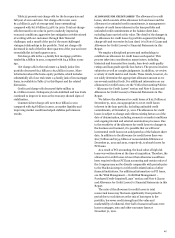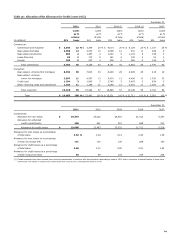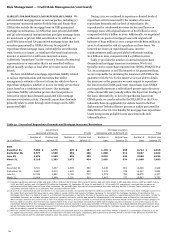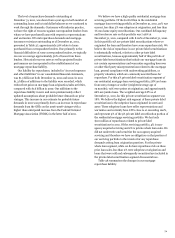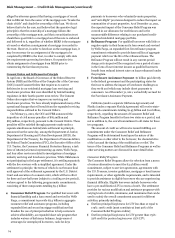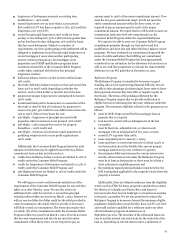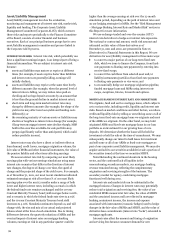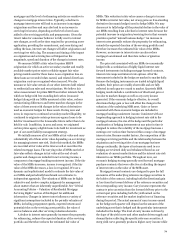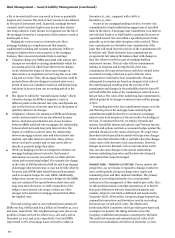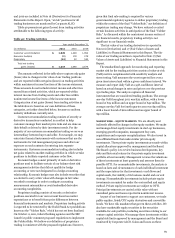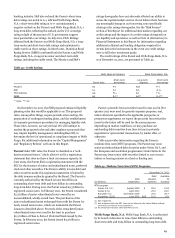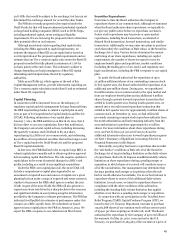Wells Fargo 2011 Annual Report Download - page 78
Download and view the complete annual report
Please find page 78 of the 2011 Wells Fargo annual report below. You can navigate through the pages in the report by either clicking on the pages listed below, or by using the keyword search tool below to find specific information within the annual report.
Risk Management — Credit Risk Management (continued)
5 years. Additionally, the original term of the loan can be
changed and the rate reduction can be executed via a
modification of the existing loan terms or a refinance into a new
loan. The new loan or modified loan must be a fully amortizing
product and the new interest rate will be capped at 100 basis
points over the Freddie Mac current primary mortgage market
survey rate or 5.25%, whichever is greater, during the initial rate
reduction period.
The credit we receive for each refinanced loan towards
satisfying the $900 million financial commitment for the
Refinance Program is calculated as the difference between the
pre-existing interest rate and the new interest rate multiplied by
the unpaid principal balance multiplied by a defined multiplier.
The defined multiplier is 5 if the rate reduction only applies for
5 years or if the remaining term is less than 10 years, 6 if the
remaining term is between 10 and 15 years, and 8 if the
remaining term is greater than 15 years. In addition, the terms of
the settlement allow for additional dollars spent on the
Refinance Program to be credited towards satisfying the
requirements of the Consumer Relief Program (25% for the first
lien principal reduction obligations and 75% for the second lien
principal reduction obligations) subject to certain caps. We will
receive credit under the Refinance Program for activities taken
on or after March 1, 2012. The Refinance Program allows for an
additional 25% credit (additional credit) for all refinance credits
earned in the first 12 months of the program. We expect that we
will be able to complete the number of refinances necessary to
satisfy the entire credit in the first 12 months of offering the
Refinance Program. If successful in this regard, the estimated
lifetime amount of interest income reduction to the portfolio will
be approximately $720 million and the additional credit earned
will be $180 million.
We expect that we will refinance approximately 20,000
borrowers with an unpaid principal balance of approximately
$4.0 billion in order to meet the commitment amount under the
Refinance Program. Based on the mix of loans we anticipate will
be refinanced, we estimate their weighted average note rate will
be reduced by approximately 260 annual basis points and that
their weighted average estimated remaining life will be
approximately 7 years. These estimates will be impacted by the
actual number of eligible borrowers that accept a refinance offer,
their existing and new note rates and the remaining term of the
actual loans refinanced. The impact of fulfilling our commitment
under the Refinance Program will be recognized over a period of
years in the form of lower interest income as qualified borrowers
benefit from reduced interest rates on loans refinanced under
the Refinance Program. Based on our expectation that we will
fulfill the credit needs for the Refinance Program within the first
12 months, we expect the future reduction in interest income to
be approximately $100 million annually. As a result of
refinancings under the Refinance Program we will be foregoing
interest that we may not otherwise have agreed to forego. No loss
was recognized in our financial statements for this estimated
foregone interest income as the impact will be recognized over a
period of years in the form of lower interest income as qualified
borrowers benefit from reduced interest rates on loans
refinanced under the Refinance Program. This impact to
foregone interest income will be increased if we do not meet our
expectation for fulfilling the total commitment for the Refinance
Program in the first twelve months. The impact of this foregone
interest income on our future net interest margin is anticipated
to be modestly adverse and will be influenced by the overall
mortgage interest rate environment, which products are
accepted by the eligible borrowers, and the pace of the execution
of the program. The Refinance Program will also impact our fair
value for these loans. The estimated reduction to the fair value of
our loans for the Refinance Program is approximately
$700 million and will be impacted by our actual execution of the
program and borrower acceptance rates.
Given that this component of the settlement relates to
borrowers in good standing as to their payment history who are
not experiencing financial difficulty, we will evaluate each
borrower to confirm their ability to repay their mortgage
obligation. This evaluation will include reviewing key credit and
underwriting policy metrics to validate that these borrowers are
not experiencing financial difficulty and therefore, actions taken
under the Refinance Program would not be considered a
troubled debt restructuring. To the extent we determine that an
eligible borrower is experiencing financial difficulty, we will
consider alternative modification programs which may result in
loans being classified and accounted for as troubled debt
restructurings.
We expect that we will be able to meet the obligations of our
commitment for the Refinance Program (and any state-level
sub-commitments) and will not be required to pay for not
meeting our commitment.
Comprehensive National Servicing Standards
The settlement also establishes comprehensive national
servicing standards that will govern loan default and foreclosure
activities. These standards reflect a new set of best practices for
mortgage servicing and not the identification of existing flaws or
errors in current servicing practices.
The national servicing
standards include:
rules governing the preparation of documentation submitted
in connection with judicial foreclosures, including
foreclosure affidavits, declarations, and sworn statements;
rules governing the preparation of evidence submitted to
support non-judicial and quasi-judicial foreclosures;
requirements for ensuring the accuracy of borrower’s account
information;
documentation of the foreclosing entity’s enforceable interest
in the note, holder status, and chain of assignment;
rules governing bankruptcy documentation and process
including proofs of claim and motions for relief from stay;
rules governing the oversight of third-party providers
including foreclosure law firms, foreclosure trustees,
subservicers, and other third parties retained to provide
foreclosure, bankruptcy, or mortgage servicing activities;
requirements for loss mitigation programs, including:
o notification to borrowers of loss mitigation options and
enhanced communication of status of loss mitigation
review;
o restriction of “dual track” progression of foreclosure
during consideration for loan modification;
o establishment of a borrower “single point of contact”;
76



